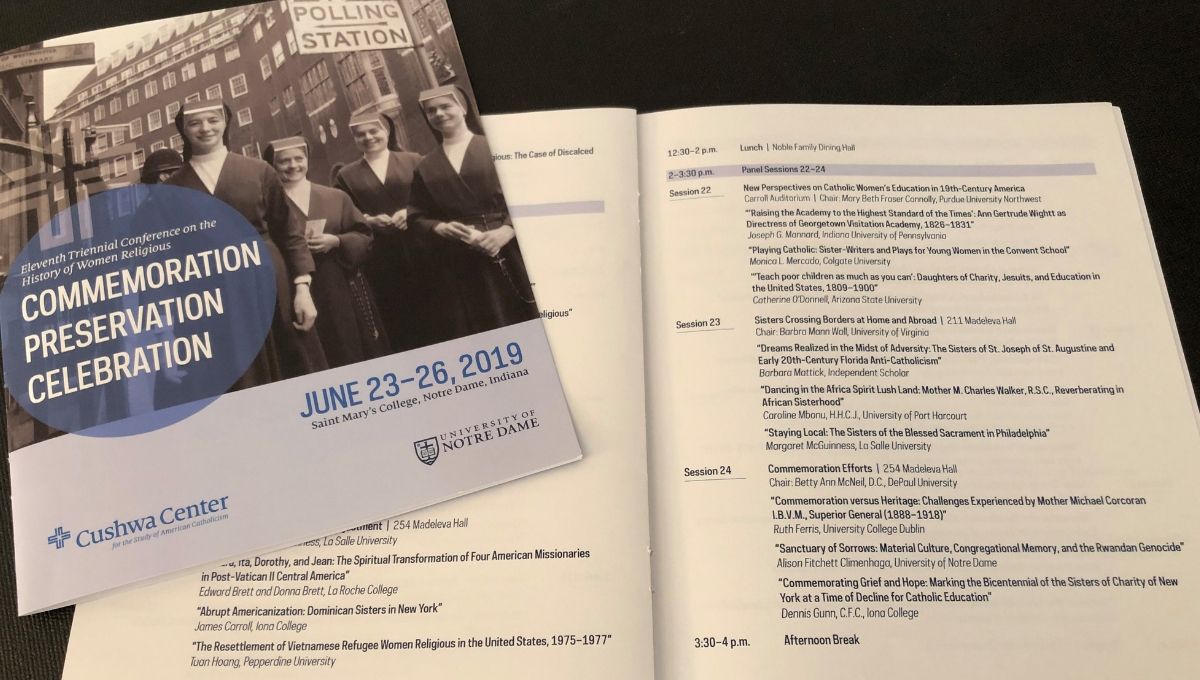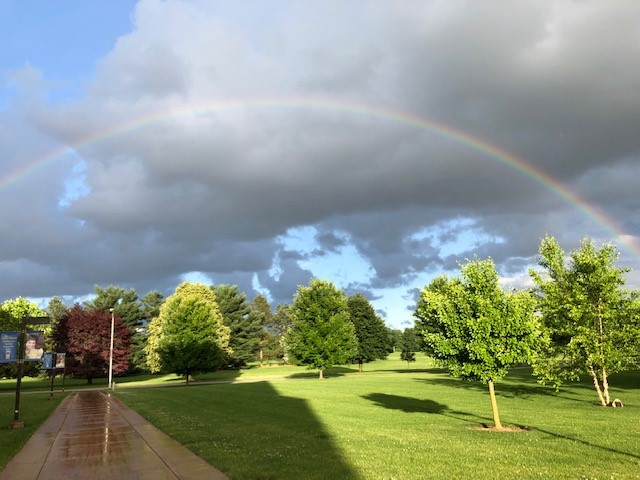
If there’s a History Heaven, it’s probably a lot like the Conference on the History of Women Religious! I was there last week along with women and men from around the world—scholars in history, sociology, the arts, and education as well as other history buffs like me.
 The conference was at Saint Mary’s College in Notre Dame, Indiana, just up the road from the Cushwa Center for the Study of American Catholicism at the University of Notre Dame, where the CHWR program resides.
The conference was at Saint Mary’s College in Notre Dame, Indiana, just up the road from the Cushwa Center for the Study of American Catholicism at the University of Notre Dame, where the CHWR program resides.
There were tons of presentations and I wanted to attend them all. With concurrent sessions and my inability to be in two places at once, sadly that wasn’t possible. But I kept a daily journal so that I could share some of the historical figures and ideas I encountered at the conference. You can find a copy of the full program here.
Sister Esther Wheelwright (1696-1780). Keynote speaker: Ann Little, PhD, Colorado State University. We’re all called by God to a vocation. The story of Sister Esther is a reminder that the call can go in unexpected directions. Sister Esther was born into a Puritan family in what is now the state of Maine. At age seven, she was captured by Wabanaki Indians after an attack on her village. The Wabanaki were Catholic, having close ties with French-Canadian Catholics who had come to the area. She lived with the Wabanaki for several years, learning their language and culture and becoming a Catholic. To receive an education, she was sent to the Ursuline nuns’ school in Quebec, where she studied with other First Peoples and French-Canadian girls. She later joined the Ursulines and became Superior of the order.
“No one ever told me these stories!” Sharing the Histories of Women Religious with Today’s Adolescents. Presenters: Katie Bugyis, PhD, Harvard University, and Ann David, PhD, University of the Incarnate Word. Step aside, Sister Encarnación and the Sisters of Quiet Mercy! High school and middle school students can learn about real Catholic sisters through an awesome English/Spanish internet resource, Called and Consecrated: Exploring the Lives of Women Religious. It’s a curriculum that helps students learn about prayer, faith, social justice, and other aspects of Catholic life through the stories of Catholic sisters today. The curriculum was designed by educators, theologians, and others and is FREE TO USE! There are student resources such as videos, podcasts, and blogs (including some from A Nun’s Life!). There are also teacher notes about how to use the curriculum, whether in a classroom, parish, diocese or other settings. Be sure to check it out! Things like this curriculum make the internet a better place!
 Fave LOL moment. Historians can be very funny, so there were many LOLs at the conference. But my favorite was in a session about using digital technologies. Professor Mary Beth Fraser Connolly described how using these technologies can be a way to raise students' interest in history and prevent “Resting Student Face."
Fave LOL moment. Historians can be very funny, so there were many LOLs at the conference. But my favorite was in a session about using digital technologies. Professor Mary Beth Fraser Connolly described how using these technologies can be a way to raise students' interest in history and prevent “Resting Student Face."
Playing Catholic: Sister-Writers and Plays for Young Women in the Convent School. Presenter: Monica Mercado, PhD, Colgate University. What does it mean to be Catholic? In the 19th century, Catholic sisters shaped the definition for many students by way of dramatic plays. At convent schools, sister-teachers and lay women wrote plays about Catholic virtues for their students to perform. This was at a time when works of fiction, including plays, were generally considered harmful to a young person's spiritual development. But the plays at the convent schools encouraged girls to behave in virtuous ways, avoiding things such as gossip, vanity, greed, and envy. The plays urged girls to make good choices. For example, in one play, a character whines that her father won’t buy her jewelry from Tiffany. Wouldn’t she be better off improving herself through education instead of whining about worldly trinkets? Why yes, yes she would.
 Just when you think things can't get more epic! Presenter: the weather. On Sunday, after the keynote speaker finished her presentation and was taking questions from the audience, tornado sirens suddenly went off. An entire auditorium of people headed to the basement, where we stayed until the danger passed. Two days later, it happened again! Only this time, it was in the middle of the dinner speaker's presentation. Back to the basement. But the weather also provided a spectacular rainbow that stretched over the whole campus.
Just when you think things can't get more epic! Presenter: the weather. On Sunday, after the keynote speaker finished her presentation and was taking questions from the audience, tornado sirens suddenly went off. An entire auditorium of people headed to the basement, where we stayed until the danger passed. Two days later, it happened again! Only this time, it was in the middle of the dinner speaker's presentation. Back to the basement. But the weather also provided a spectacular rainbow that stretched over the whole campus.